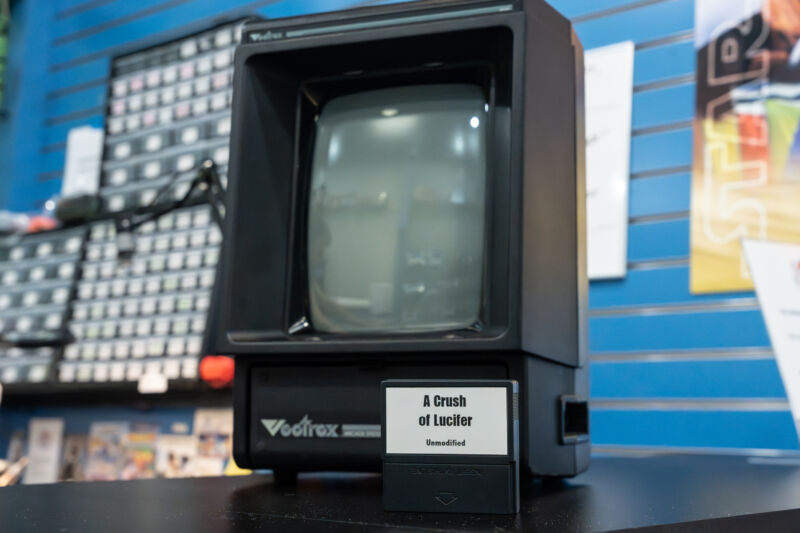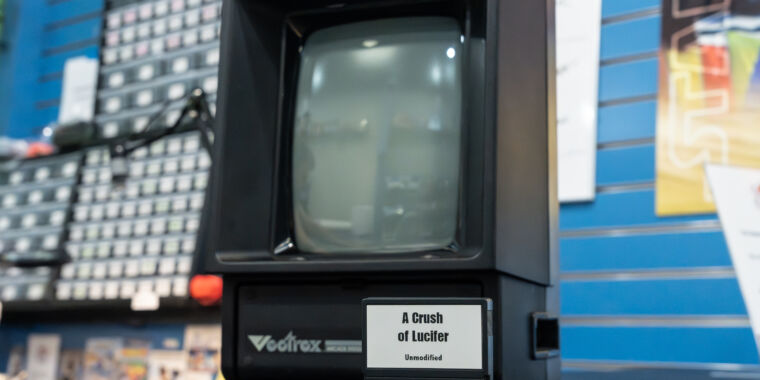Vectrex reborn: How a chance encounter gave new life to a dead console
Vector Graphics —
40 years later, it’s time for the Vectrex to shine.

Enlarge / A Vectrex console and CRT display with a cart for a long-lost game.
Tim Stevens
The Vectrex may be the most innovative video game console you’ve never heard of. It had everything it needed to prompt a revolution, including controllers far more sophisticated than the competition and the ability to render polygons a decade before gaming’s 3D revolution.
It was years ahead of anything else on the market, yet it could not have launched at a worse time. The Vectrex hit stores at the tail end of 1982. Over the next six months, the then-booming video game market went bust. The Vectrex, a potential revolution in home gaming, was swept into bargain bins, forgotten by all but the most ardent of collectors.
Forty years later, it’s having something of a comeback. New developers are breathing fresh code into this aged machine, hardware hackers and tinkerers are ensuring that tired capacitors and CRTs stay functional, and a new game has seen retail release after sitting unplayed for four decades.
This, finally, could be the Vectrex’s time to shine.
Vectrex history
1982 was a banner year for video games. Titles like Zaxxon, Pole Position, Q*bert, and Dig Dug were fresh in the arcades. In the home gaming scene, seemingly unquenchable consumer desire fueled a period of innovation unlike anything the now $200 billion industry has seen since.
To give some context, Sony sold 11.8 million PlayStation 5s in 2021, the console’s first full year of availability. Back in 1982, 12 million Atari 2600 home consoles flew off store shelves, despite the nascent home gaming industry amounting to a paltry $4 billion.
This boom drove the creation of the Vectrex. The system was born at LA-based hardware design firm Smith Engineering. Envisioned as a portable system with a tiny, 1-inch cathode ray tube screen, the Vectrex concept ultimately grew into the 9-inch screen production version you see here.
Kenner Toys was initially slated to release the system, but when that deal fell through, General Consumer Electronics (GCE) stepped in and brought it to market in late 1982 after a successful debut at that summer’s Consumer Electronics Show. The Vectrex’s initial buzz was so successful that Milton Bradley acquired GCE in 1983.
The Vectrex design was unique, a video game console wholly integrated into a portrait-oriented CRT. This was at a time when most households had just a single television set. Playing Atari back then meant fighting with your siblings and parents about who had control of the TV because missing an episode of The A-Team had real consequences. Not only was DVR technology still decades away, Sony was still trying to say that recording television programs on VCR cassettes was illegal.
But the real reason for the Vectrex’s integrated display was its reliance on a display technique not seen on a home system before (nor since). Vector graphics are a true rarity on the gaming scene. 1979’s Asteroids is probably the most famous example, while 1983’s Star Wars is far and away the most impressive.
Outside of a few exceptions, every video game you’ve ever played has been made up of a series of pixels. Whether it’s CRT, LCD, LED, or even OLED, you’re still talking about images made up of tiny dots of light. As the years have progressed, those pixels have gotten smaller and smaller. Likewise, the graphical power provided by advanced GPU systems like the GeForce RTX 4090 allows those pixels to assemble into ever-more realistic 3D worlds.
Ultimately, though, it’s all a bunch of pixels. On the Vectrex, there are no pixels. As its name implies, graphics here are all made up of vectors. That means straight beams of light drawn from A to B, electrons shot straight and narrow onto a cathode ray tube that glows in response. Connect three such lines, and you have a triangle, a simple polygon, the building block of all mainstream 3D gaming even today.
That lack of pixels means that, even 40 years on, watching a Vectrex game in action is an oddly captivating thing. There’s a fluidity in the rudimentary graphics, an innate sharpness that was not only lacking in other games of the period but that still looks novel today.
Overall fidelity, however, is admittedly low. Though color TVs were well and truly mainstream by 1983, the Vectrex is decidedly black and white, a problem “solved” by some crafty, budget-minded engineering. Most Vectrex titles came with a transparent overlay, a full-color sheet of plastic that clips in place over the display, injecting some hue into the unfortunately desaturated CRT.
Powering this was a relatively simple set of silicon with an 8-bit Motorola 6809 microprocessor at its heart, the same processor behind arcade classics like Robotron: 2084 and many later Williams pinball machines. It ran at a mighty 1 MHz with a whole 1KB of RAM at its disposal.
The chip was paired with an integrated control pad with an analog joystick, far more advanced than the four-way joysticks found on every other home console controller at the time.
All that specialized hardware led to a specialized price. The Vectrex launched in 1982 at $199—about $650 in 2023 dollars. Less than 18 months later, it was dead.
The collector
Sean Kelly is among the world’s preeminent video game collectors. “I’ve been collecting video games for a long time,” he told me. “I’ve had probably over 100,000 video games pass through my hands over the years.” At one point, he said, he had more than 50,000 in his garage.
If that sounds like an industrial operation rather than a mere obsession, you’re not wrong. Kelly is co-founder of the National Videogame Museum in Frisco, Texas, established in 2016 and home to many unicorns of video game collecting, like an original Nintendo World Championship cartridge.
Perhaps it was an affinity for another failed early ’80s console—the Intellivision—that initially fostered Kelly’s love of video games, but he’s had a huge hand in keeping the Vectrex alive. He began by releasing so-called multi-carts, Vectrex cartridges that contained multiple discrete games accessed first by toggling DIP switches and later via a software menu.
Considering many Vectrex titles saw limited releases or no release at all, multi-carts like this were the only way for those few die-hard fans of the system to ever have a chance of playing them.
One of those games was Mail Plane, where you plot optimal delivery routes, then load up the packages and navigate across the country.
Thanks to the Vectrex’s abrupt cancellation, Mail Plane never saw release. You’d be forgiven for thinking it had, though. At Sean’s website, VectrexMulti, you’ll find boxed copies of Mail Plane ready to order.
The game comes in the silvery packaging that was standard for Vectrex releases in its day and even comes with a light pen, a peripheral used for keying in those delivery routes.
Kelly sourced manufacturers for every aspect of the retail packaging. Different prototype versions of the game code were floating around, but Kelly says most were incomplete. “In addition to collecting the video games, I’ve also had a passion for hunting down the people that used to produce the games,” he said. This began a quest to find the most complete version of Mail Plane.
“We would find this former employee or that former employee had a couple of cartridges, and we would go through the cartridges and look at them,” Kelly said, and he ultimately sourced the one closest to final. “Nobody knows for sure if it’s 100 percent complete, but generally, we believe that that’s the most complete version.”
He gave other games the same treatment, including Tour de France, in which you frantically pedal across a polygonal route to Paris, grabbing water bottles along the way and carefully managing the stamina of your rider. It’s an odd title, one that Kelly laments hasn’t exactly been a sales success. “Tour de France is one of the ones that I will be buried with,” he said. “I lost money on Tour de France.”
Kelly declined to say which games have made money, but it’s clear in speaking to him that this is all about passion, not profits.
Along the way, releasing those games provided Kelly and his associates with some valuable experience ahead of a surprise: the discovery of a game that seemingly nobody, not even those who worked for GCE or Milton Bradley, had ever heard of.
Vectrex reborn: How a chance encounter gave new life to a dead console Read More »
